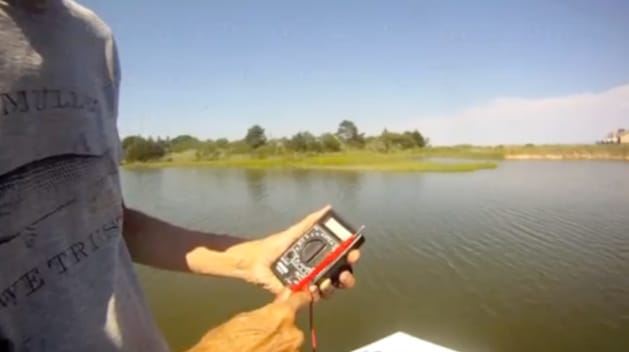
Zinc Anode Failure
Electrolysis is a catchall term used to describe all kinds of electro-chemical processes, from hair-removal to electroplating. Only a landlubber uses it to describe marine corrosion. What experienced boaters want to know is whether their boat suffers from galvanic corrosion or stray current corrosion. What follows is a primer on the two, and a video briefly describing the use of a multimeter and a silver/silver chloride reference electrode, or “half-cell”, (available from www.pmariner.com and other retailers) to determine your boat’s state of corrosion affairs.
Galvanic Corrosion
Galvanic corrosion occurs when two dissimilar metals are immersed in an electrolyte (water) and are electrically connected. When immersed and connected these create a cell, like a battery, and the current produced can be measured. Corrosion of the more noble metal (the cathode) will be reduced at the expense of the less noble metal (the anode) which will corrode more rapidly.
Basically, zinc, aluminum and magnesium anodes are fastened to marine metals because these are more noble and will corrode first, sacrificing themselves to save your pricey equipment.
Any boat needs some form of protection against galvanic corrosion, since most have at least some dissimilar metal fittings or equipment. The question is how much? The consequences of too little protection are obvious: corroded equipment. But too much protection, known as “over-zincing”, can cause failure of antifouling coatings and other problems.
A multimeter and a reference anode can tell you if your boat is properly protected against galvanic corrosion.
Stray Current Corrosion
Stray current corrosion occurs when electric current escapes from its intended path, which is normally through the wiring, and uses your boat, or its underwater fittings, as the new path. Even a moist surface can carry stray current. It can occur due to poor connections, failing insulation, improper support of wires and improper original installation. This is a more severe kind of corrosion than galvanism and causes very rapid metal loss. Stray current corrosion can and does sink boats by corroding through-hull fittings. And it can do so in less than a week.
The stray current can come from your boat, or from a neighboring boat. It occurs because of faulty wiring, and even the wiring of your marina or waterfront residence can be to blame.
A reference electrode and a multimeter can tell you if your boat is undergoing attack by stray current corrosion.
Takeaway: When connected to shorepower, your boat is connected to every other boat on that circuit via the ground wire. We recommend equipping your boat with an isolation transformer, or, at the very least, a galvanic isolator.
Suggested Reading
Sniffing Out Boat Electrical Problems
Sacrificial Anode Faux Pas and Tips
Ten Great Boating Tips









